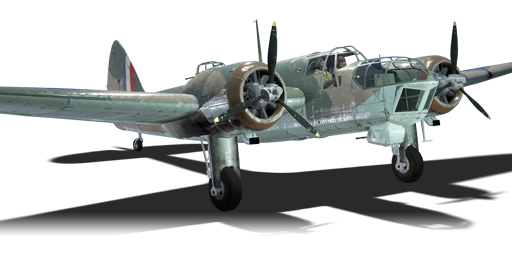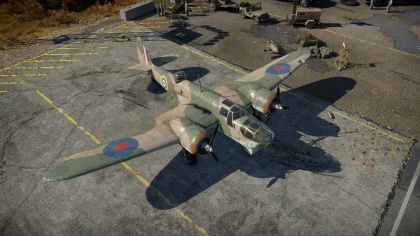Blenheim Mk IV
Contents
Description
The Blenheim Mk IV is a rank British light bomber
with a battle rating of (AB), (RB), and (SB). This bomber has been in the game since the start of the Open Beta Test prior to Update 1.29.
The Blenheim IV is a light bomber, therefore base bombing in Realistic Battles isn't recommended, as the armament of 2 x 500 lbs bombs isn't enough for one or two runs against a base. The Blenheim's advantage over other bombers is its speed, so remembering and implementing this into tactics is vital. Low and fast tactics are normally best, try to avoid flying at medium altitudes or high altitudes, as accuracy will drop and you will be weak against attacks from below. Although the "red-line" speed of the Blenheim is high, dive bombing isn't as accurate as level bombing, so try to fly very low over the target to ensure a hit with the weaker payloads. The front turret guns are excellent for the "drive-by" method of attack against un-armoured targets- this is an advised tactic to carry through to the Beaufort - the wing mounted gun was intended as a range finder in real life but can ground attack un-armoured targets, with time and patience, although the turret method is easier.
The plane can also be used as a fighter. This is due to its supreme low-speed turn capabilities. The Blenheim turns into a Spitfire with flaps deployed, and the elevator fully extended. Surprising as it may sound, the frontal armament may prove devastating when used in a correct way. That is, if you load tracers, for not only unlike other ammunition choices it gives you a rough idea where the shells are going, but also it consists of the best shell composition, with a decent chance to light fires. As for the turrets, load universal, again due to its best shell composition.
The Blenheim can be absolutely deadly to other early planes, particularly as the biplanes it will be up against are often flown by inexperienced pilots who tend to position themselves right behind bombers at very close range while attacking -- in other words, their planes will be stationary relative to the gunner, and at such a close range that he simply cannot miss. Thus, a single Blenheim bomber picking off large numbers of enemy planes is a common sight. The Blenheim has one forward-firing weapon, but it's mounted far out on the wing, so hitting targets with it effectively requires some practice.
General info
Flight Performance
| Characteristics | |||||||
|---|---|---|---|---|---|---|---|
| Stock | |||||||
| Max Speed (km/h at 3,692 m) |
Max altitude (meters) |
Turn time (seconds) |
Rate of climb (meters/second) |
Take-off run (meters) | |||
| AB | RB | AB | RB | AB | RB | ||
| 404 | 393 | 8,310 | 27.3 | 27.7 | 2.3? | 4.1 | 366 |
| Upgraded | |||||||
| Max Speed (km/h at 3,692 m) |
Max altitude (meters) | Turn time (seconds) | Rate of climb (meters/second) |
Take-off run (meters) | |||
| AB | RB | AB | RB | AB | RB | ||
| 453 | 428 | 8,310 | 24.8 | 26.0 | 15.4 | 7.6 | 366 |
Details
| Features | ||||
|---|---|---|---|---|
| Combat flap | Take-off flap | Landing flap | Air brakes | Arrestor gear |
| ✓ | ✓ | ✓ | X | X |
| Limits | ||||
|---|---|---|---|---|
| Wing-break speed (km/h) |
Gear limit (km/h) |
Combat flap (km/h) |
Max Static G | |
| + | - | |||
| 550 | 225 | 401 | ~4 | ~2 |
| Optimal velocities | |||
|---|---|---|---|
| Ailerons (km/h) |
Rudder (km/h) |
Elevators (km/h) |
Radiator (km/h) |
| < 315 | < 310 | < 350 | > 250 |
| Compressor (RB/SB) | ||
|---|---|---|
| Setting 1 | ||
| Optimal altitude | 100% Engine power | WEP Engine power |
| 4,000 m | 1,660 hp | 2,137 hp |
Survivability and armour
- 1 mm Dural - Engine protective plate (one for each engine)
- 12.7 mm Steel - Armored pilot and co-pilot seats
- 12.7 mm Steel - Armored gunner's seat
Armaments
Offensive armament
The Blenheim Mk IV is armed with:
- 1 x 7.7 mm Browning .303 machine gun, left wing-mounted (500 rpg)
Suspended armament
Main article: Bombs
The Blenheim Mk IV can be outfitted with the following ordinance:
- 4 x G.P 250 lb Mk IV bombs (1,000 lb total)
- 2 x G.P 500 lb Mk IV bombs (1,000 lb total)
Defensive armament
The Blenheim Mk IV is defended by:
- 2 x 7.7 mm Vickers K machine gun, ventral turret (500 rpg = 1,000 total)
- 2 x 7.7 mm Browning machine gun, dorsal turret (500 rpg = 1,000 total)
Usage in the battles
In order to be successful in shooting enemy aircraft, one needs to either immediately drop the bomb, or (on small maps like Bastogne, or Essen) dive down, and release on the first target spotted. Then it's just a matter of flying a plane like a Spitfire - turn fighting at low altitude, and sometimes stall fighting, and making all sorts of evasive manoeuvres (though this might seem ridiculous, do not worry, the plane really is capable of supporting such handling). When turning it is important to remember that the plane will rip during sharp turns at speeds exceeding 350 kph. Obviously, at some point, you will get an enemy on your tail. Then, your defensive gunners come into play. All you need to do is to swing the tail of the aircraft around, and fire at the enemy with either your top or bottom turret. It is also a good idea to first fire off all the ammunition in one of the turrets, and while it is reloading use the second one.
If you are down tiered, you can use your speed to completely avoid some enemy fighters. At a decent altitude (3,000 m or above works best), biplanes will not be able to catch you and low tier monoplanes will struggle.
One last thing about the turrets: they both have a 360 degrees firing arch. This means, that you may also use them offensively (especially when engaging bombers, with whom you may exchange broadsides, or when the offensive armament has run out of ammunition).
Manual Engine Control
| MEC elements | ||||||
|---|---|---|---|---|---|---|
| Mixer | Pitch | Radiator | Supercharger | Turbocharger | ||
| Oil | Water | Type | ||||
| Controllable | Not controllable | Not controllable | Not controllable | Separate | Not ontrollable | Not controllable |
Modules
| Tier | Flight performance | Survivability | Weaponry | |||
|---|---|---|---|---|---|---|
| I | Fuselage Repair | Radiator | MBC-B | |||
| II | Compressor | Airframe | Turret 7 mm | New 7 mm MGs | Offensive 7 mm | |
| III | Wings Repair | Engine | New 7 mm MGs (turret) | |||
| IV | Engine Injection | Cover | New 7 mm MGs (turret) | |||
Pros and cons
Pros:
- Very high speed for its rank
- Great turn time
- Forward-firing machine gun
- Ventral and dorsal turrets on the same aircraft are rare at its tier
- Excellent coverage for ventral and dorsal turrets
- Defensive turrets are excellent against unarmoured aircraft
Cons:
- Very vulnerable when the gunner is taken out
- Turrets lack punch, particularly when compared to the Beaufort
- Poor bomb load, even for its tier
- Offensive machine gun lacks any firepower
- No bulletproof glass or armour to protect the pilots from head-on attacks
History
Making the first mission of WW2, then the next day, the first bombing raid, the Blenheim Mk IV was a vital part of the RAF's early war effort. It became obsolete in 1942 as newer planes and technology made the Bristol Blenheim outdated. Dimensions : Length: 13.00 m Width: 17.17 m Height: 3.91 m
In-game description
"Originally developed as a prototype fast civilian transport aircraft, the Bristol Blenheim was a British light bomber widely used during the early days of the Second World War. The Blenheim was the first British all-metal aircraft and one of the first with a retractable landing gear, an electric defensive turret and a variable pitch propeller. Conversion from fixed-gear biplane bombers with fixed-pitch propellers to Blenheims, with their modern features, proved troublesome for some squadrons. Large numbers of levers, often poorly positioned, had great potential to cause confusion in critical stages of flight. For example, the landing gear lever was close to the flap lever, which sometimes led to retraction of flaps together with landing gear at takeoff, causing an immediate loss of lift. Improper prop pitch setting at takeoff often led to an overly long takeoff run and passing the runway threshold without becoming airborne.
The Blenheim Mk IV was not, as is often thought, a variant of the Mk I. Rather it was based on the Type 149 variant, based on the 11/36 requirement for a coastal reconnaissance/light bomber to replace the Avro Anson. During flight trials the Mk IV reached a top speed of 266 mph; faster than the Mk I. However, the data was misleading as the speed was reached at 12,000 ft, whereas the Mk I was tested at sea level, where it reached 239 mph - the Mk I was slightly faster at altitude. Unfortunately, this became obvious in combat, when Mk IVs fared no better against Luftwaffe fighters than the Mk I. It quickly became clear that Blenheims needed fighter escorts.
Whilst certainly one of the world’s fastest aircraft during the prototype phase in 1935, the Blenheim did not have the speed to compete with enemy fighters by 1939. This, combined with its poor defensive armament and light payload made it an unsuccessful bomber, but tragically for the crews of RAF Bomber Command, it was available in large numbers. The Blenheim squadron losses up to 1941 were amongst the worst suffered by the RAF during the entire war. A modification of the Blenheim MkI did, however, have some notable successes as a pioneering night fighter until more suitable aircraft were developed in that role."
Media
An excellent addition to the article will be video guides, as well as screenshots from the game and photos.
Read also
Links to the articles on the War Thunder Wiki that you think will be useful for the reader, for example,
- reference to the series of the aircraft;
- links to approximate analogues of other nations and research trees.
Sources
Paste links to sources and external resources, such as:
- topic on the official game forum;
- page on aircraft encyclopedia;
- other literature.
| Britain bombers | |
|---|---|
| Torpedo | Swordfish Mk I · Swordfish Mk II · ▄Avenger Mk II |
| Dive | V-156-B1 |
| Hydroplanes | ▄Catalina Mk IIIa · Sunderland Mk IIIa · Sunderland Mk V |
| Light | Blenheim Mk IV · Beaufort Mk VIII · ▄Hudson Mk V · Brigand B 1 |
| Based on A20 | ▄Havoc Mk I · ▄Boston Mk I · ▄DB-7 |
| Hampden | Hampden Mk I · Hampden TB Mk I |
| Wellington | Wellington Mk Ic · Wellington Mk Ic/L · Wellington Mk III · Wellington Mk X |
| Halifax | Halifax B Mk IIIa |
| Stirling | Stirling B Mk I · Stirling B Mk III |
| Lancaster | Lancaster B Mk I · Lancaster B Mk III |
| Lincoln | Lincoln B Mk II |
| Shackleton | Shackleton MR.Mk.2 |





